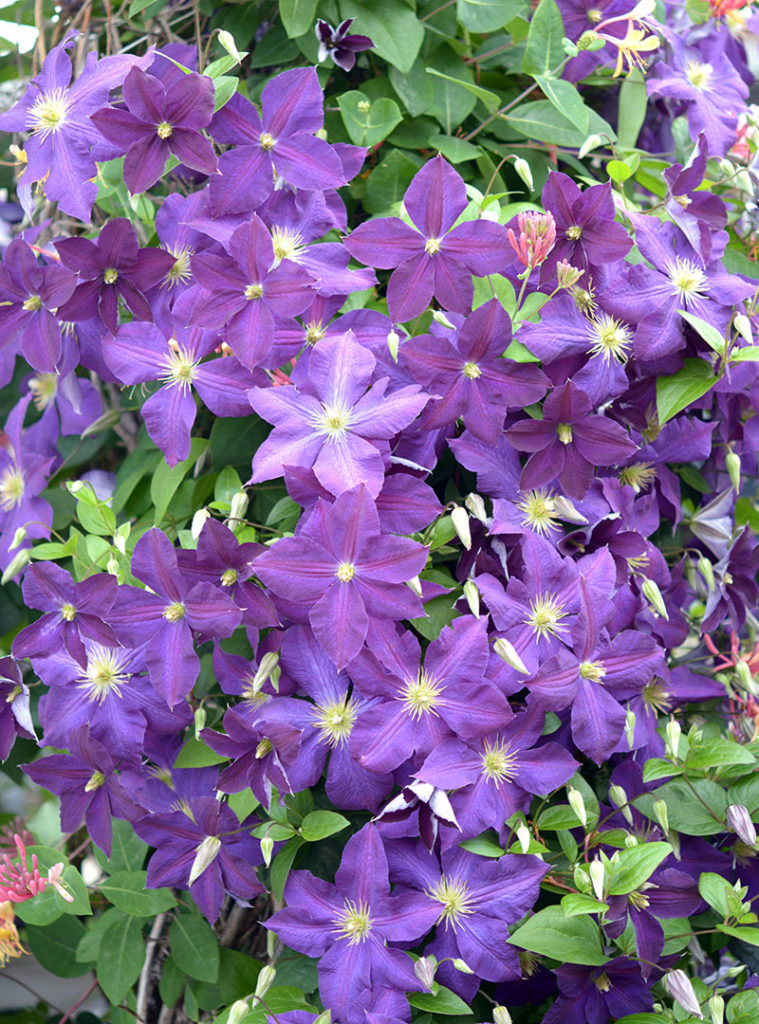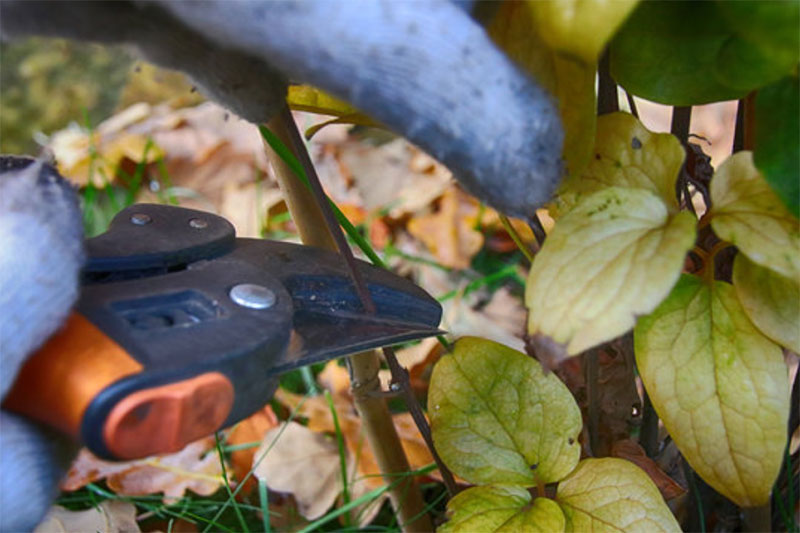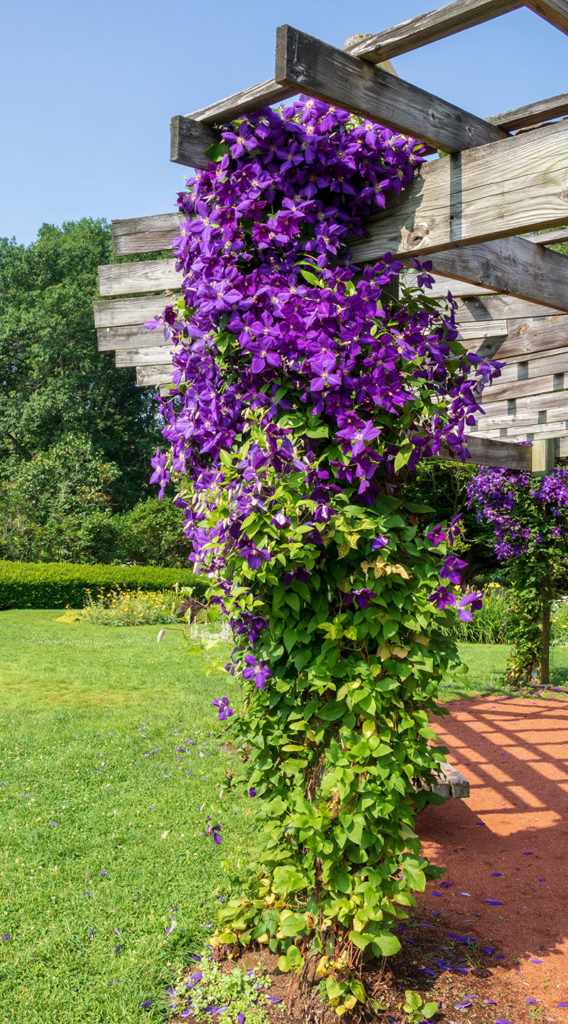Gardening is a way of showing that you believe in tomorrow.
Tips for Planting & Pruning Clematis
Clematis Planting Guide
Clematis like to be planted with “their feet in the shade and their heads in the sun”. This can be accomplished in several ways. The roots can be shaded with other plants, like a groundcover, other smaller perennials, shrubs or mulch. If you use mulch make sure it stays about 2”-3” away from the stems to encourage good air circulation.

Planting in outdoor beds:
Find a location where the soil drains well as Clematis do not like waterlogged feet! If there is still standing water 5-6 hours after a soaking rain, find another place, or amend the soil with organic matter to raise the level of the planting area. Waiting until the soil has warmed (around the beginning of June in zone 4b) will help the plant to sprout and grow quickly.
Site Clematis where they will receive full sun to part sun (usually facing south or west), and sheltered from strong or drying winds.
Dig a hole, gently teasing out the plants roots and spread them in the hole. Make sure the soil on the root ball is about 1” below the level of the planting area. Tuck the plant in and tamp down gently to remove any air pockets.
Water generously by soaking the soil. Make sure they get at least 1” of water, or a bit more, each week during this first year and thereafter. Water lightly into the fall and until freeze up.
Tips for Pruning Clematis
Clematis can live for up to 50 years! Proper pruning can protect your plant and help it thrive and look it’s best. Pruning isn’t that complicated, and incorrect pruning is rarely fatal. The worst that can happen is you won’t have flowers for a year. That being said, Clematis can be divided into 3 groups, either 1, 2 or 3 (or sometimes A, B or C). For pruning purposes, you will need to know to which group your Clematis belongs. If you don’t know which pruning group your Clematis belongs to, a quick search on-line may be the fastest way to figure it out.
Follow the pruning tips below to encourage multiple stems and healthy root development.
Pruning young clematis
Young clematis need to develop both roots and top growth at the same time. So restrain top growth by keeping young plants pruned to 18”-24” for the first year, no matter what pruning group it belongs to. This encourages root development, better branching and multiple buds below the soil. Yes, flowering is delayed but the sacrifice is well worth it in building a healthy plant for the future.
Pruning Group 1 or A (Early-flowering)
These flower on old wood which is last season’s growth. They are the earliest clematis to flower, usually June in zone 4b. Just a light pruning to remove the dead stems and neaten it up a bit is all that is needed. Wait until the leaves are emerging on the rest of the plant, then prune to the topmost pair of strong buds, slowly, section by section, from the top down, thus avoiding removing live wood and the blooms that would have resulted. If you have a very old or overgrown Clematis in this category, it can be pruned back hard right after flowering has ended. This will give the plant time to put out the new growth that will flower next spring.
Pruning Group 2 or B (Mid-spring to Early Summer Flowering)
This one gets a bit complicated, as the flowers appear on both old and new wood. Typically they flower heavily in the spring, and then again modestly in fall. Prune lightly, remove dead and weak wood first. The largest flowers are produced on old wood, so be careful not to remove too much! Prune from the top down, finding the good buds and cut just above that. If the stems are growing in a jumble, this is a good time to untangle, readjust and reattach the remaining stems to their support. If you have a very old or overgrown Clematis in this category, it can be pruned back hard right after flowering has ended. This will give the plant time to put out the new growth that will flower in the fall. There are some varieties in this category that simply don’t pause in their blooming. You will just have to ‘bite the bullet’ so to speak and chop the budded stems back by about 1/3.
If, for some special reason, you want the flowering to be heaviest late in the season, cut back hard in the spring!
Also, many double flowered varieties carry the double flowers on old wood. Hard pruning may result in single flowers, although they may throw an occasional double. And many of the newer hybrids bear double flowers on both old and new wood.
Pruning Group 3 or C (Late-flowering)
This group calls for some ruthless pruning! Ignore the emerging foliage further up the stem and simply cut back to about 8”-12” with 2 sets of buds per stem. Your reward for this unscrupulous pruning is vigorous new shoots and a full, multi-stemmed plant filled with lots of flowers. Don’t be afraid to guide and train the stems with a firm hand. These are exuberant plants!
*Tip: Wear gloves when pruning clematis. The wood splinters easily
*Tip: After pruning in Wisconsin and areas with alkaline soils, it’s a good idea to feed with a good all-purpose fertilizer and bone meal. If your soil is more acid add lime and phosphate.
*Tip: Clean up pruned leaves and stems by throwing them in the trash, never the compost pile.


